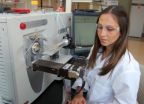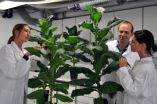(Press-News.org) This press release is available in German.
Animals are more eloquent than previously assumed. Even the monosyllabic call of the banded mongoose is structured and thus comparable with the vowel and consonant system of human speech. Behavioral biologists from the University of Zurich have thus become the first to demonstrate that animals communicate with even smaller sound units than syllables.
When humans speak, they structure individual syllables with the aid of vowels and consonants. Due to their anatomy, animals can only produce a limited number of distinguishable sounds and calls. Complex animal sound expressions such as whale and bird songs are formed because smaller sound units – so-called "syllables" or "phonocodes" – are repeatedly combined into new arrangements. However, it was previously assumed that monosyllabic sound expressions such as contact or alarm calls do not have any combinational structures. Behavioral biologist Marta Manser and her doctoral student David Jansen from the University of Zurich have now proved that the monosyllabic calls of banded mongooses are structured and contain different information. They thus demonstrate for the first time that animals also have a sound expression structure that bears a certain similarity to the vowel and consonant system of human speech.
Single syllable provides information on the identity and activity of the caller
The research was conducted on wild banded mongooses at a research station in Uganda. For their study, the scientists used a combination of detailed behavior observations, recordings of calls and acoustic analyses of contact calls. Such a call lasts for between 50 and 150 milliseconds and can be construed as a single 'syllable'. Jansen and his colleagues now reveal that, despite their brevity, the monosyllabic calls of banded mongooses exhibit several temporally segregated vocal signatures. They suspected that these were important so studied the individual calls for evidence of individuality and behavior. "The initial sound of the call provides information on the identity of the animal calling," explains Jansen. The second more tonal part of the call, which is similar to a vowel, however, indicates the caller's current activity.
Structured single syllables in animals not an exception?
Manser and her team are thus the first to demonstrate that animals also structure single syllables – much like vowels and consonants in human speech. The researchers are convinced that the banded mongoose is not the only animal species that is able to structure syllables. They assume that the phenomenon was overlooked in scientific studies thus far. For instance, they point out that frogs and bats also structure single syllables. "The example of banded mongooses shows that so-called simple animal sound expressions might be far more complex than was previously thought possible."
INFORMATION:
Banded mongooses:
Banded mongooses (Mungo mungos) live in the savannah regions south of the Sahara. They are small predators that live in social communities and are related to the meerkat (Suricata suricatta). Banded mongooses differ from meerkats and other mammals that rear their young cooperatively in that several females have offspring. In the case of meerkats, however, only the dominant female has young.
Banded mongoose groups each comprise around twenty adult animals. The group looks after the young animals, defends its territory jointly and forages as a unit. As soon as the young go foraging with the group, they enter into an exclusive, one-on-one relationship with an adult animal, an escort. The young recognize their escort based on its call and are able to distinguish it from other group members. Banded mongooses have a wide range of sounds and coordinate their activities by this means, which enables them to maintain group cohesion.
Banded mongooses structure monosyllabic sounds in a similar way to humans
2013-01-10
ELSE PRESS RELEASES FROM THIS DATE:
New report: The reach and impact of mathematical sciences
2013-01-10
The Mathematical Sciences in 2025, a new report from the National Research Council, finds that the mathematical sciences are an increasingly integral component of many disciplines -- including biology, medicine, the social sciences, business, advanced design, and climate studies. However, the expanding role of the mathematical sciences over the past 15 years has not been matched by a comparable increase in federal funding, and the number of federal agencies that provide significant support for this research is considerably smaller than the number that profit from it.
The ...
Is there a period of increased vulnerability for repeat traumatic brain injury?
2013-01-10
New Rochelle, NY, January 10, 2013—Repeat traumatic brain injury affects a subgroup of the 3.5 million people who suffer head trauma each year. Even a mild repeat TBI that occurs when the brain is still recovering from an initial injury can result in poorer outcomes, especially in children and young adults. A metabolic marker that could serve as the basis for new mild TBI vulnerability guidelines is described in an article in Journal of Neurotrauma, a peer-reviewed journal from Mary Ann Liebert, Inc., publishers. The article is available free on the Journal of Neurotrauma ...
New tool to help brain surgeons 1 step closer to operating room
2013-01-10
WEST LAFAYETTE, Ind. - A new tool that could allow for faster, more comprehensive testing of brain tissue during surgery successfully identified the cancer type, grade and tumor margins in five brain surgery patients, according to a Purdue University and Brigham and Women's Hospital study.
The tool sprays a microscopic stream of charged solvent onto the tissue surface to gather information about its molecular makeup and produces a color-coded image that reveals the nature and concentration of tumor cells.
Researchers analyzed specimens removed from the patients, but ...
Scientists design, control movements of molecular motor
2013-01-10
ATHENS, Ohio (Jan. 10, 2013)—An international team of scientists has taken the next step in creating nanoscale machines by designing a multi-component molecular motor that can be moved clockwise and counterclockwise.
Although researchers can rotate or switch individual molecules on and off, the new study is the first to create a stand-alone molecular motor that has multiple parts, said Saw-Wai Hla, an Ohio University professor of physics and astronomy who led the study with Christian Joachim of A*Star in Singapore and CEMES/CNRS in France and Gwenael Rapenne of CEMES/CNRS. ...
Giant tobacco plants that stay young forever
2013-01-10
The life of tobacco plants is short. They grow for around three to four months, followed by flowering and then die. Their size is also limited, with plants only growing to about one-and-a-half to two meters tall. Now, researchers at the Fraunhofer Institute for Molecular Biology and Applied Ecology IME in Münster have located the tobacco plant's very own fountain of youth, which means they can keep it forever young. The Münster-based researchers discovered a genetic switch which can prevent the plants from change blooming to flowering. This also averts the plants' early ...
Surgeons may use hand gestures to manipulate MRI images in OR
2013-01-10
WEST LAFAYETTE, Ind. — Doctors may soon be using a system in the operating room that recognizes hand gestures as commands to tell a computer to browse and display medical images of the patient during a surgery.
Surgeons routinely need to review medical images and records during surgery, but stepping away from the operating table and touching a keyboard and mouse can delay the procedure and increase the risk of spreading infection-causing bacteria, said Juan Pablo Wachs, an assistant professor of industrial engineering at Purdue University.
"One of the most ubiquitous ...
Which study strategies make the grade?
2013-01-10
Students everywhere, put down those highlighters and pick up some flashcards! Some of the most popular study strategies — such as highlighting and even rereading — don't show much promise for improving student learning, according to a new report published in Psychological Science in the Public Interest, a journal of the Association for Psychological Science.
In the report, John Dunlosky of Kent State University and a team of distinguished psychological scientists review the scientific evidence for ten learning techniques commonly used by students.
"Schools and parents ...
Cutting in and weaving irritate drivers the most, new CAMH study on road rage shows
2013-01-10
January 10, 2013 (Toronto) - Cutting in and weaving, speeding, and hostile displays are among the top online complaints posted by drivers, according to a new study by the Centre for Addiction and Mental Health (CAMH) recently published in an online issue of Accident Analysis and Prevention.
Driver aggression is a major safety concern and researchers estimate this behaviour is a factor in nearly half of all motor vehicle collisions. Identifying the underlying causes and strategies for preventing driver aggression continues to be a priority.
CAMH researcher Dr. Christine ...
High-frequency stock trading of little value to investors, general public
2013-01-10
The increase in the speed of stock trading from microseconds to nanoseconds leads to an increase in order cancellation, but little else of value to investors and the general public, says research by a University of Illinois business professor.
According to a forthcoming study by Mao Ye, a professor of finance at Illinois, the arms race in speed at the sub-millisecond level of stock trading is a "purely positional game" in which a trader's payoff depends on transaction speed relative to other traders.
"There are lots of extreme views about high-frequency trading, but ...
Decline in available liver transplants expected
2013-01-10
A new study, funded in part by the National Institutes of Health (NIH) and Health Resources and Services Administration, and published in the January 2013 issue of Liver Transplantation, a journal of the American Association for the Study of Liver Diseases (AASLD), found that the non-use of donor livers climbed through 2010 due to a worsening of donor liver quality, primarily from donation following cardiac death. Diabetes, donor age, and body mass index (BMI) were also linked to a decrease in use of organs.
"For patients with end-stage liver disease, transplantation ...






